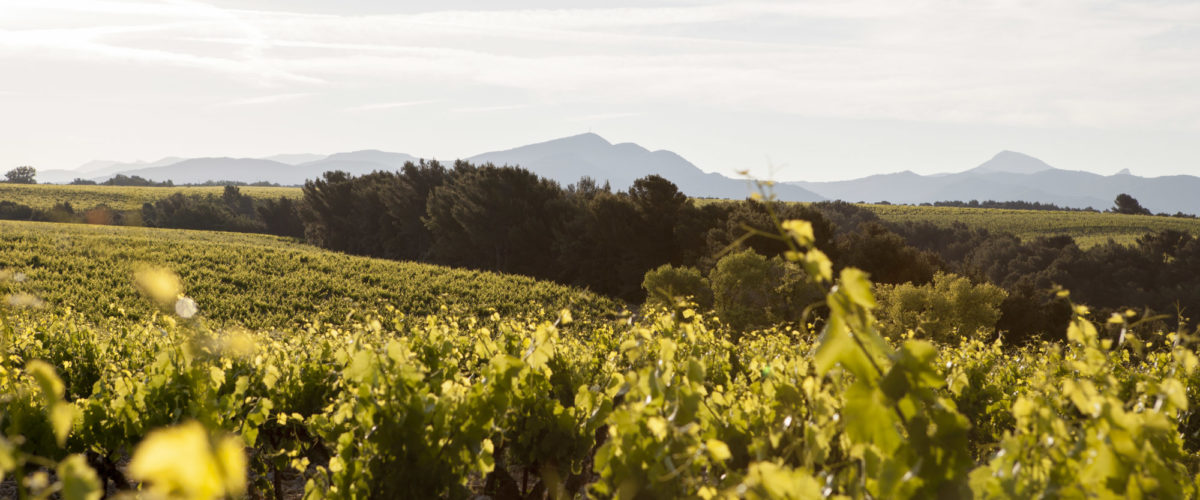
Vineyards
FACTBOX
Domaine la Florane: 75.5 hectares, comprising 38.5ha of vines and 37ha of woodland, olive trees and lavender.
DEUX TERROIRS
Côtes-du-Rhône Villages Visan appellation
24 hectares
Altitude: 280 to 380 metres
Terroir: south-facing valley – called a “coste chaude” (sunny hillside) in Provençal.
Côtes-du-Rhône Villages Saint-Maurice appellation
14.5 hectares and as much woodland (formerly Domaine de l’Échevin)
Altitude: 380 to 410 metres
Terroir: plateau with chalky-clay soil, covered with pebbles, and north/north-east facing
Terroirs & Features
A green haven surrounded by broom, century-old oak trees (Holm, white, and even a few truffle oaks), olive trees… A mix of varieties on monovarietal plots.
Formation of the two terroirs
explained by geologist Georges Truc
Terroir strengths
The Visan terroir is a scale of notes that lets each vigneron play their score.
Some 24,000 millennia have made this terroir what it is today.
It all began in the Miocene Epoch. The Mediterranean Sea covered the Rhône Valley, and met with rivers that flowed down the young mountains of La Lance and Ventoux, conveying large amounts of sand and clay which were captured by the coastal currents.
More deposits followed
Quaternary Period alluvium containing a greater proportion of pebbles, carried by the rivers that run close to or through the municipality today (Lez, Aygues, Corone, Hérein). It built up to a thickness of 600 metres, filling the sea. It turned into today’s very soft sandstone, known locally as safres, which forms the foundation of the hillsides where vines grow in our terroir.
A 100-metre layer of gravel and clay, spread out by rivers 10 million years ago.
A composition of great finesse: This long history has given our soil a very fine composition, combining sandy, chalky-clay and stony land.
But several fundamental qualities are found throughout the estate
The soil is well ventilated through efficient drainage, without altering the nutritional alliance between soil and vine.
The heat-retaining effect of the pebbles protects the vines from cold snaps.
A persistent water reserve, which the clay releases to the grapes as the heat rises.
These three properties of the Visan soils are enhanced by three climate features:
A powerful Mistral, which keeps the vines healthy.
Highly seasonal rainfall (spring and autumn).
Plentiful sunshine during the two dry seasons (a short winter and a very hot summer).
Method of vine cultivation
Organic and biodynamically farming (Demeter and Biodyvin certified).
VIGNERONS
Adrien Fabre and his father François, the second and third generations.
VISAN
Visan belonged to the Knights Templar before passing into papal ownership in 1344; it was part of the Papal Enclave for nearly five centuries. After lengthy negotiations, Pope Clement VI traded Visan to the Dauphin (French heir apparent) Humbert II for a debt write-off. Visan became part of France permanently by decree in 1793, in the department of Vaucluse and the canton of Valréas.
The village wall built by the popes, and all the handsome Renaissance et Baroque townhouses, have been conserved. Visan still has a very fine historical core in the old village, which rises from 276 to 397 metres in altitude. If you come to see us, visit Rue des Nobles!
In Notre-Dame-des-Vines chapel, in one of the arches of the choir, is the inscription “prosuerunt me custodem in vinae”: “here they placed me, the custodian of their vines”.
In 1966, Visan was granted Côtes-du-Rhône Villages status.
SAINT MAURICE
Saint-Maurice refers to a Roman officer, Mauritius, who led the Theban legion that came from Egypt. He was converted to Christianity at the same time as his soldiers. Rather than break his pledge of peace to the Christian opponents of Emperor Maximinus’s regime, he refused to fight them. His cohort was decimated, and Mauritius was martyred in the early fourth century. The small village of Saint-Maurice was then built around vineyards guarded by the proudest Christian centurions.
Already cultivated in the Gallo-Roman age, vines developed quickly in the 14th century, when the village belonged to France’s heirs apparent. In the 18th century, the wines of Saint-Maurice were renowned thanks to the “Tinto” variety (Mourvèdre), grown amid the olive trees, and to sherry.
In 1952, Saint-Maurice was given Côtes-du-Rhône status.
And in 1964, the appellation was granted Côtes-du-Rhône Villages Communaux status [allowing the village to put its name on the label – Translator’s Note].
The terraced vineyards, on north and south facing hillsides, enjoy the most possible sunshine and are sheltered from the prevailing wind, the Mistral.